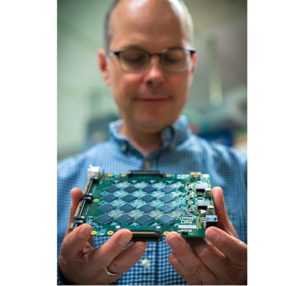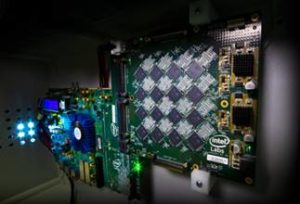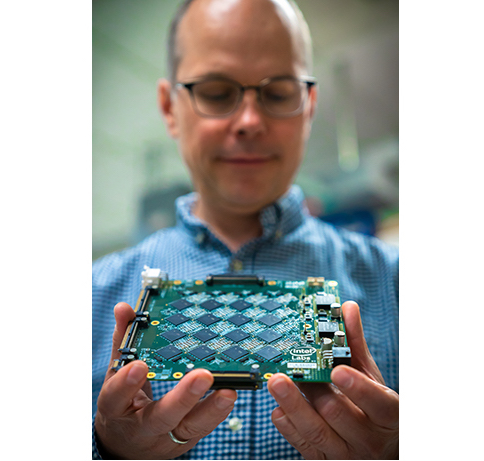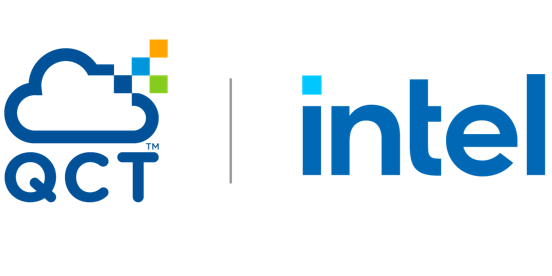
Rich Uhlig, managing director of Intel Labs, holds one of Intel’s Nahuku boards, each of which contains 8 to 32 Intel Loihi neuromorphic chips. Intel’s latest neuromorphic system, Pohoiki Beach, is made up of multiple Nahuku boards and contains 64 Loihi chips. Pohoiki Beach was introduced in July 2019. (Credit: Tim Herman/Intel Corporation)
At the DARPA ERI summit this week, Intel Labs director Rich Uhlig unveiled “Pohoiki Beach” – a 64-Loihi Chip Neuromorphic system capable of simulating eight million neurons. Now available to the broader research community, the Pohoiki Beach enables researchers to experiment with Intel’s brain-inspired research chip, Loihi, which applies the principles found in the biological brains to computer architectures.
We are impressed with the early results demonstrated as we scale Loihi to create more powerful neuromorphic systems,” said Uhlig. “Pohoiki Beach will now be available to more than 60 ecosystem partners, who will use this specialized system to solve complex, compute-intensive problems.”
Loihi enables users to process information up to 1,000 times faster and 10,000 times more efficiently than CPUs for specialized applications like sparse coding, graph search and constraint-satisfaction problems. With the introduction of Pohoiki Beach, researchers can now efficiently scale up novel neural-inspired algorithms — such as sparse coding, simultaneous localization and mapping (SLAM), and path planning — that can learn and adapt based on data inputs. Pohoiki Beach represents a major milestone in Intel’s neuromorphic research, laying the foundation for Intel Labs to scale the architecture to 100 million neurons later this year.
Continuing the gains in power and performance enabled by Moore’s Law will require more than continued process-node scaling. As new complex computing workloads become the norm, there is a growing need for specialized architectures designed for specific applications.
The Pohoiki Beach neuromorphic system demonstrates the benefits of a specialized architecture for emerging applications, including some of the computational problems hardest for the internet of things (IoT) and autonomous devices to support. By using this type of specialized system, as opposed to general-purpose computing technologies, we can expect to realize orders of magnitude gains in speed and efficiency for a range of real-world applications, from autonomous vehicles to smart homes to cybersecurity.
 With the introduction of Pohoiki Beach, Intel will allow ecosystem partners worldwide to continue to pioneer the next frontier of neural-inspired algorithmic research.
With the introduction of Pohoiki Beach, Intel will allow ecosystem partners worldwide to continue to pioneer the next frontier of neural-inspired algorithmic research.
With the Loihi chip we’ve been able to demonstrate 109x lower power consumption running a real-time deep learning benchmark compared to a GPU, and 5x lower power consumption compared to specialized IoT inference hardware,” said Chris Eliasmith, co-CEO of Applied Brain Research and professor at University of Waterloo. “Even better, as we scale the network up by 50x, Loihi maintains real-time performance results and uses only 30 percent more power, whereas the IoT hardware uses 500 percent more power and is no longer real-time.”
Later this year, Intel will introduce an even larger Loihi system named Pohoiki Springs, which will build on the Pohoiki Beach architecture to deliver an unprecedented level of performance and efficiency for scaled-up neuromorphic workloads.
Intel’s engineers expect that measurements from these research systems will quantify the gains that are achievable with neuromorphic-computing methods, and will clarify the application areas most suitable for the technology. This research paves the way for the eventual commercialization of neuromorphic technology.




